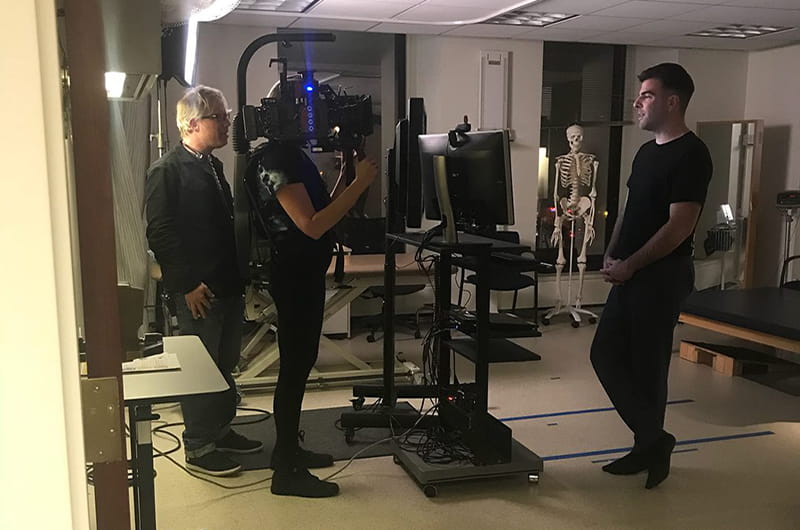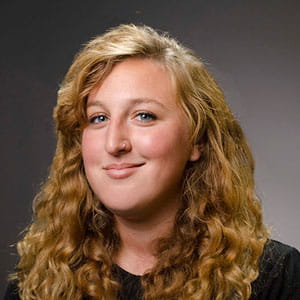History Channel Show Visits Drexel ‘In Search Of’ Superhuman Answers

Is it really possible to be superhuman? That’s what actor Zachary Quinto tried to figure out as the host of the History Channel’s new “In Search Of” show — enlisting the help of a Drexel University professor to discover some answers.
The episode featuring Stella Volpe, PhD, professor and chair of the Department of Nutrition Sciences in the College of Nursing and Health Professions, explored aspects of superhuman nature, like extreme feats of strength and endurance. As a nutritionist and exercise physiologist, Volpe regularly tests for bone mineral density — a measurement of the amount of calcium and mineral in bones that demonstrates how strong bones are — and she scanned both Quinto and a Shaolin warrior monk known as the Abbott to test the denseness, or strength, of their bones and skulls.
The Abbott, one of the superhumans tested in the episode, practices Shaolin kung fu, which is one of the oldest and most famous styles of kung fu and combines Zen Buddhism and martial arts. For years, he had trained and meditated to build up strength and endure pain. For example, to become a monk, one of the tests he had to pass included burning nine incense sticks on his head — one at a time, for nine minutes each.
The feat of strength he demonstrated on “In Search Of” was less about heat and more about brute force. He was filmed meditating and performing special movements before breaking a wooden staff over his head, a move that would give most people a concussion or intense head injury. Amazingly, the Abbott didn’t sustain any injury or have his nervous system record any “fight or flight” response — instead, he actually lowered his body temperature and decreased his heartbreak to get into a calmer state and withstand the impact of the wooden staff.
How was this possible? In search of answers, the show turned to Volpe for some help.
Though the show aired on July 27, Volpe had her parts filmed in November 2017, about a month after a producer for the show contacted the College to see if there were any experts who could test the strength and vitals of a Shaolin monk and the host of the show. Volpe was that expert.
“I wanted to be a part of this, as a scientist, because it sounded so interesting to me,” Volpe said.
She agreed — but she had no idea who the host was until she showed up and saw Quinto, whom she knew as the actor who played the updated version of Leonard Nimoy’s Spock in the rebooted Star Trek movies and would later host the rebooted version of “In Search Of,” which Nimoy hosted in the ’70s and ’80s (which Volpe remembers watching).
The day of the film shoot, Arun Ramakrishnan, PhD, director of research labs in the College of Nursing and Health Professions, helped prepare Drexel’s Dual-energy X-ray Absorptiometry (DXA) Lab, one of the College’s research lab facilities dealing with physiological strength, for the visit.
As shown in the show, Volpe tested both the Abbott and Quinto (who did not attempt to break a stick with his face) to compare the strength of their bones. The whole shoot took about two hours, and about three or four dozen crew members filmed in the research space as Volpe talked to Quinto and the Abbott on and off camera.
“Both of them were so nice,” she said. “The Abbott is originally from Italy, so when I found that out, I spoke Italian to him. My parents were both from Italy, so I grew up speaking Italian, and I also lived in Italy for a few months for work. He was so warm and so kind to talk to.”
Quinto was 11 years younger than the Abbott and had greater bone mineral density measured in his bones and skull — but surprisingly, the Abbott was the one who had performed superior feats of strength. After the testing, the three of them got together to talk, unscripted, about the difference in bone densities.
“If I did the exercise that the Abbott did this afternoon, breaking that stick on my head, I feel like I would just be in hospital,” Quinto said to Volpe. “So is there a way to explain the capacity for him to be able to do that?”
“That’s a great question because I think that goes to specificity of the way you train [gesturing to the Abbot],” Volpe replied. “We don’t work out to allow ourselves to do that. That is the biggest difference of why, for example, you and I would hurt ourselves.”
In the end, it really was an extreme case of mind over matter — as would be proven again later in the episode when the Abbott’s brain measured little pain points when he submerged his hand in a bowl of ice water, while being measured in an MRI.
After Volpe watched the entire episode — which included segments about a man who ripped a door off of a burning car in an adrenaline-fueled moment of extreme strength and a man who couldn’t feel pain — she said it was “fun to watch how all the parts were brought together.”
“I don’t know if this experience will affect my research, but what I can tell you is it certainly made me think more in my workouts,” said Volpe. “It really is so much about mind over matter.”
In This Article
Drexel News is produced by
University Marketing and Communications.

